Strategic Management Report
VerifiedAdded on 2020/02/05
|11
|3797
|175
Report
AI Summary
This report critically analyzes the challenges and benefits of merger and acquisition strategies within the energy sector, specifically focusing on the period of 2014-2016 when oil prices crashed. It utilizes academic models such as Porter's Five Forces and the McKinsey 7S Model to examine internal and external factors influencing these strategies. The report uses the Shell-BG Group merger as a case study, highlighting both the advantages (market expansion, cost reduction) and disadvantages (cultural clashes, management integration challenges). The analysis considers various factors such as competitive rivalry, threat of substitutes, buyer and supplier power, cultural integration, legal implications, and economies of scale. The conclusion emphasizes the importance of carefully considering both the potential benefits and drawbacks before implementing merger and acquisition strategies in the volatile energy market.
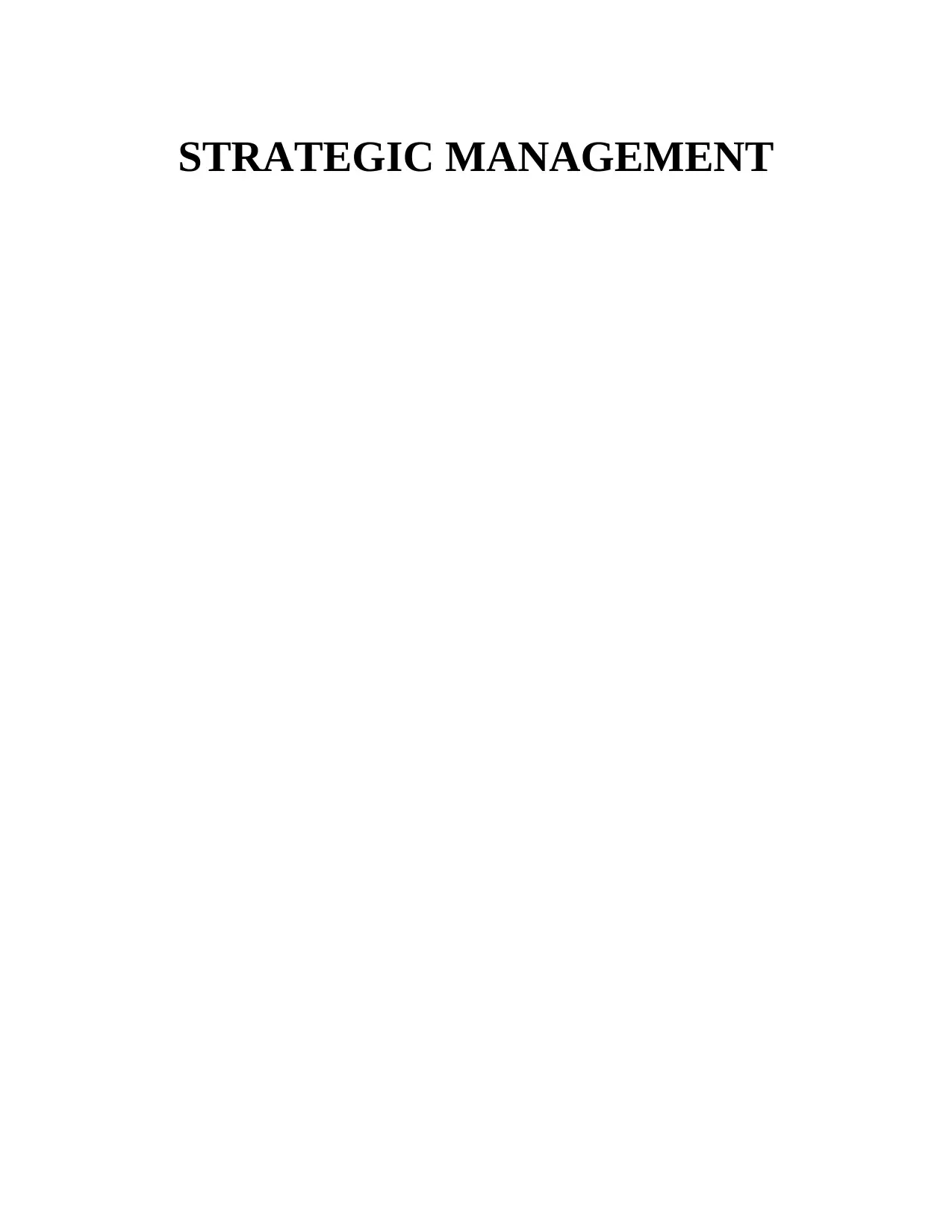
STRATEGIC MANAGEMENT
Paraphrase This Document
Need a fresh take? Get an instant paraphrase of this document with our AI Paraphraser
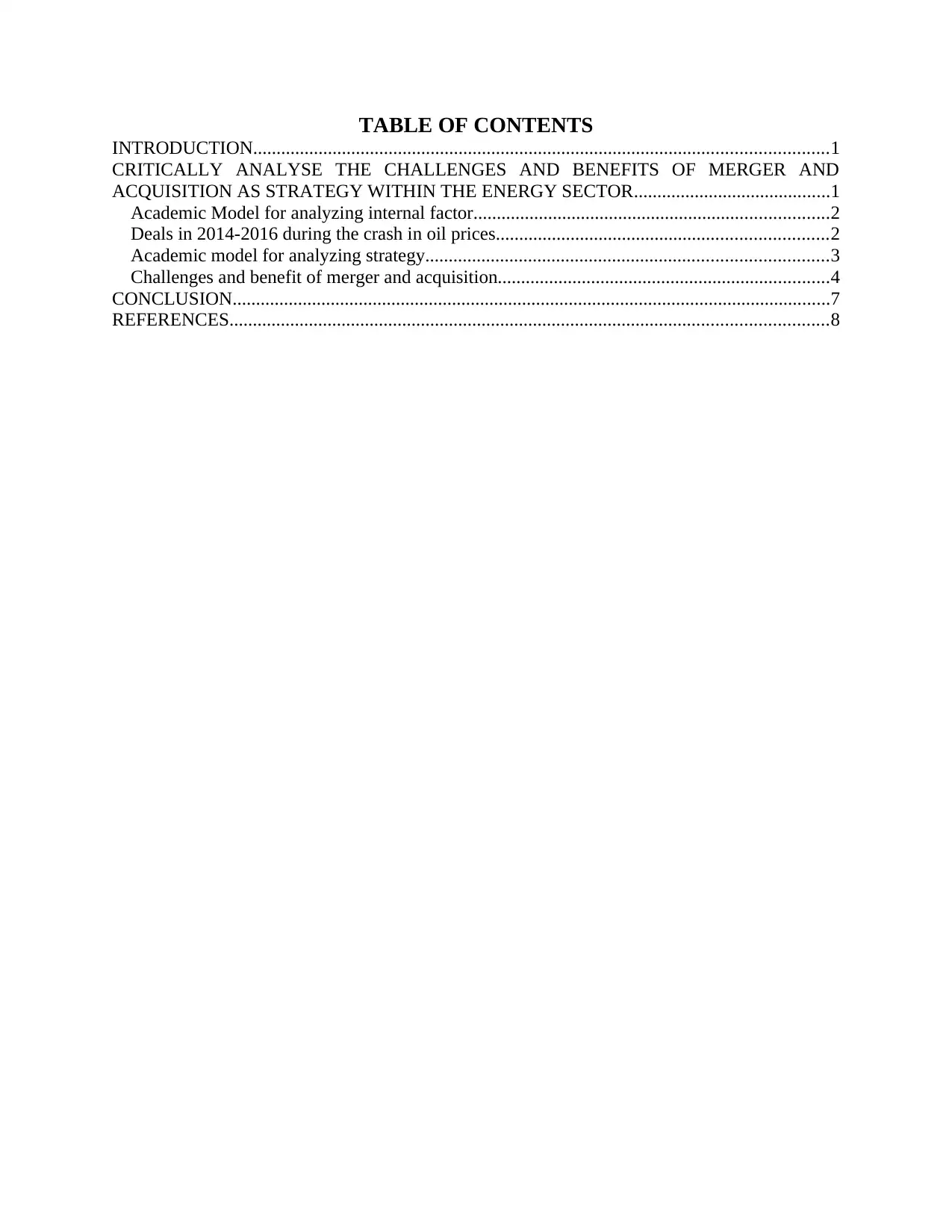
TABLE OF CONTENTS
INTRODUCTION...........................................................................................................................1
CRITICALLY ANALYSE THE CHALLENGES AND BENEFITS OF MERGER AND
ACQUISITION AS STRATEGY WITHIN THE ENERGY SECTOR..........................................1
Academic Model for analyzing internal factor............................................................................2
Deals in 2014-2016 during the crash in oil prices.......................................................................2
Academic model for analyzing strategy......................................................................................3
Challenges and benefit of merger and acquisition.......................................................................4
CONCLUSION................................................................................................................................7
REFERENCES................................................................................................................................8
INTRODUCTION...........................................................................................................................1
CRITICALLY ANALYSE THE CHALLENGES AND BENEFITS OF MERGER AND
ACQUISITION AS STRATEGY WITHIN THE ENERGY SECTOR..........................................1
Academic Model for analyzing internal factor............................................................................2
Deals in 2014-2016 during the crash in oil prices.......................................................................2
Academic model for analyzing strategy......................................................................................3
Challenges and benefit of merger and acquisition.......................................................................4
CONCLUSION................................................................................................................................7
REFERENCES................................................................................................................................8
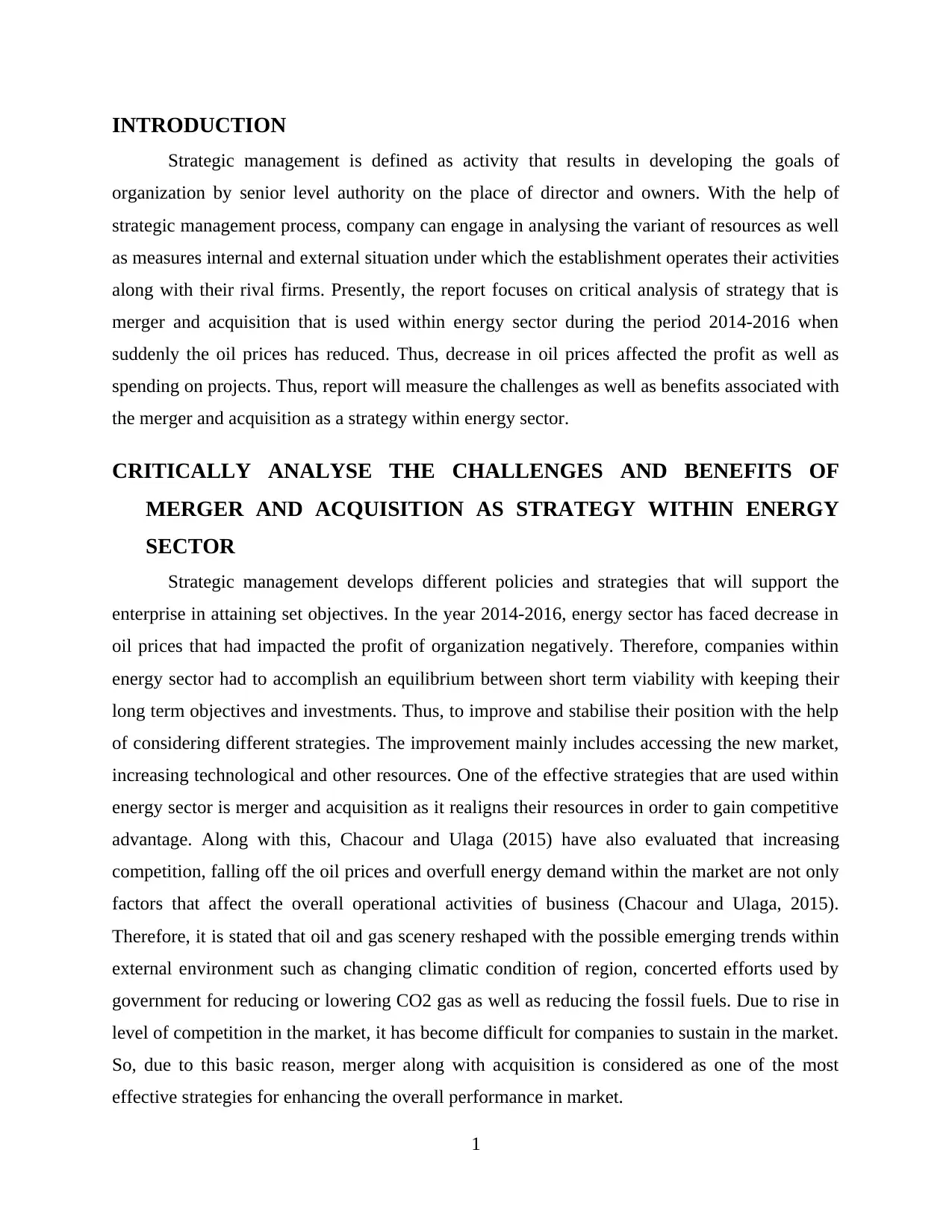
INTRODUCTION
Strategic management is defined as activity that results in developing the goals of
organization by senior level authority on the place of director and owners. With the help of
strategic management process, company can engage in analysing the variant of resources as well
as measures internal and external situation under which the establishment operates their activities
along with their rival firms. Presently, the report focuses on critical analysis of strategy that is
merger and acquisition that is used within energy sector during the period 2014-2016 when
suddenly the oil prices has reduced. Thus, decrease in oil prices affected the profit as well as
spending on projects. Thus, report will measure the challenges as well as benefits associated with
the merger and acquisition as a strategy within energy sector.
CRITICALLY ANALYSE THE CHALLENGES AND BENEFITS OF
MERGER AND ACQUISITION AS STRATEGY WITHIN ENERGY
SECTOR
Strategic management develops different policies and strategies that will support the
enterprise in attaining set objectives. In the year 2014-2016, energy sector has faced decrease in
oil prices that had impacted the profit of organization negatively. Therefore, companies within
energy sector had to accomplish an equilibrium between short term viability with keeping their
long term objectives and investments. Thus, to improve and stabilise their position with the help
of considering different strategies. The improvement mainly includes accessing the new market,
increasing technological and other resources. One of the effective strategies that are used within
energy sector is merger and acquisition as it realigns their resources in order to gain competitive
advantage. Along with this, Chacour and Ulaga (2015) have also evaluated that increasing
competition, falling off the oil prices and overfull energy demand within the market are not only
factors that affect the overall operational activities of business (Chacour and Ulaga, 2015).
Therefore, it is stated that oil and gas scenery reshaped with the possible emerging trends within
external environment such as changing climatic condition of region, concerted efforts used by
government for reducing or lowering CO2 gas as well as reducing the fossil fuels. Due to rise in
level of competition in the market, it has become difficult for companies to sustain in the market.
So, due to this basic reason, merger along with acquisition is considered as one of the most
effective strategies for enhancing the overall performance in market.
1
Strategic management is defined as activity that results in developing the goals of
organization by senior level authority on the place of director and owners. With the help of
strategic management process, company can engage in analysing the variant of resources as well
as measures internal and external situation under which the establishment operates their activities
along with their rival firms. Presently, the report focuses on critical analysis of strategy that is
merger and acquisition that is used within energy sector during the period 2014-2016 when
suddenly the oil prices has reduced. Thus, decrease in oil prices affected the profit as well as
spending on projects. Thus, report will measure the challenges as well as benefits associated with
the merger and acquisition as a strategy within energy sector.
CRITICALLY ANALYSE THE CHALLENGES AND BENEFITS OF
MERGER AND ACQUISITION AS STRATEGY WITHIN ENERGY
SECTOR
Strategic management develops different policies and strategies that will support the
enterprise in attaining set objectives. In the year 2014-2016, energy sector has faced decrease in
oil prices that had impacted the profit of organization negatively. Therefore, companies within
energy sector had to accomplish an equilibrium between short term viability with keeping their
long term objectives and investments. Thus, to improve and stabilise their position with the help
of considering different strategies. The improvement mainly includes accessing the new market,
increasing technological and other resources. One of the effective strategies that are used within
energy sector is merger and acquisition as it realigns their resources in order to gain competitive
advantage. Along with this, Chacour and Ulaga (2015) have also evaluated that increasing
competition, falling off the oil prices and overfull energy demand within the market are not only
factors that affect the overall operational activities of business (Chacour and Ulaga, 2015).
Therefore, it is stated that oil and gas scenery reshaped with the possible emerging trends within
external environment such as changing climatic condition of region, concerted efforts used by
government for reducing or lowering CO2 gas as well as reducing the fossil fuels. Due to rise in
level of competition in the market, it has become difficult for companies to sustain in the market.
So, due to this basic reason, merger along with acquisition is considered as one of the most
effective strategies for enhancing the overall performance in market.
1
⊘ This is a preview!⊘
Do you want full access?
Subscribe today to unlock all pages.

Trusted by 1+ million students worldwide
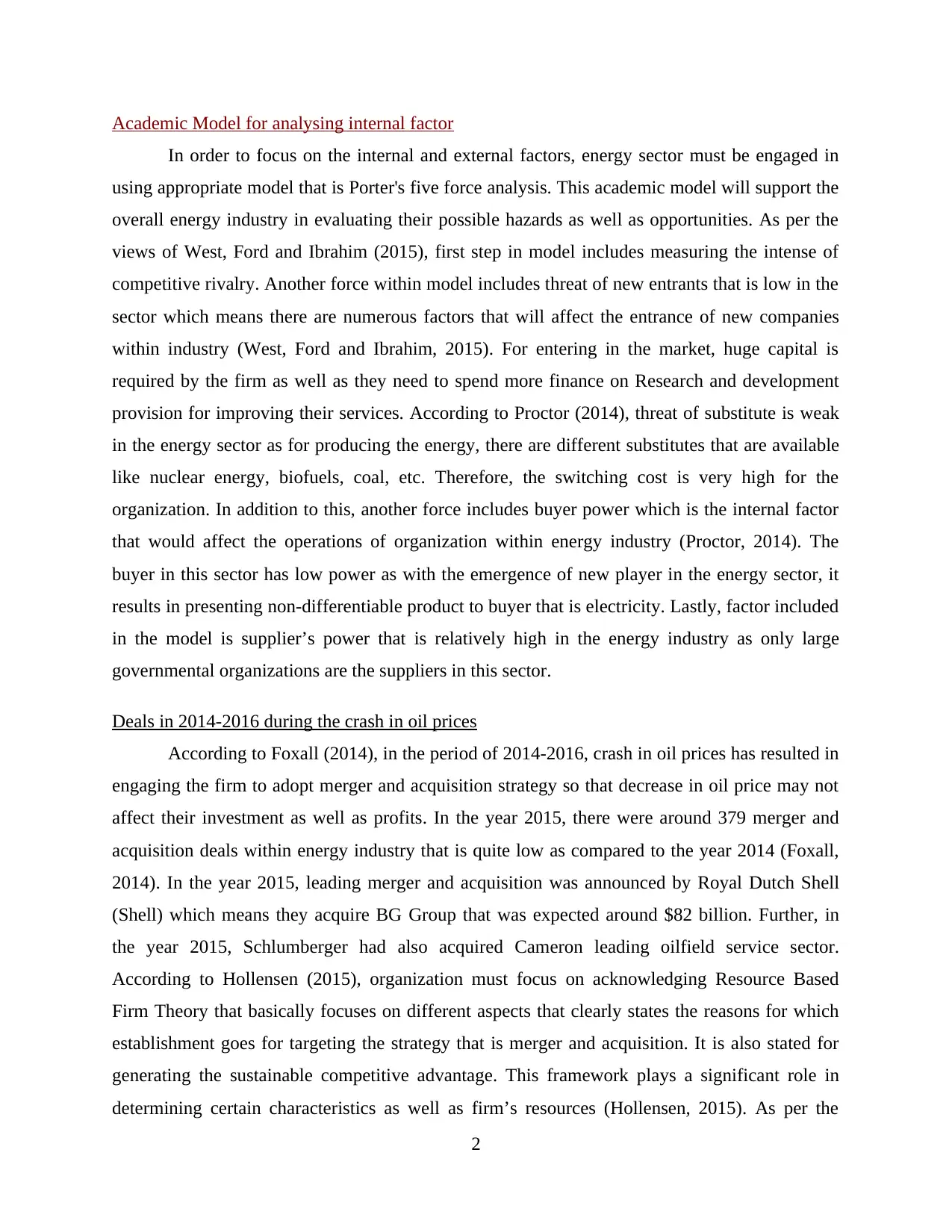
Academic Model for analysing internal factor
In order to focus on the internal and external factors, energy sector must be engaged in
using appropriate model that is Porter's five force analysis. This academic model will support the
overall energy industry in evaluating their possible hazards as well as opportunities. As per the
views of West, Ford and Ibrahim (2015), first step in model includes measuring the intense of
competitive rivalry. Another force within model includes threat of new entrants that is low in the
sector which means there are numerous factors that will affect the entrance of new companies
within industry (West, Ford and Ibrahim, 2015). For entering in the market, huge capital is
required by the firm as well as they need to spend more finance on Research and development
provision for improving their services. According to Proctor (2014), threat of substitute is weak
in the energy sector as for producing the energy, there are different substitutes that are available
like nuclear energy, biofuels, coal, etc. Therefore, the switching cost is very high for the
organization. In addition to this, another force includes buyer power which is the internal factor
that would affect the operations of organization within energy industry (Proctor, 2014). The
buyer in this sector has low power as with the emergence of new player in the energy sector, it
results in presenting non-differentiable product to buyer that is electricity. Lastly, factor included
in the model is supplier’s power that is relatively high in the energy industry as only large
governmental organizations are the suppliers in this sector.
Deals in 2014-2016 during the crash in oil prices
According to Foxall (2014), in the period of 2014-2016, crash in oil prices has resulted in
engaging the firm to adopt merger and acquisition strategy so that decrease in oil price may not
affect their investment as well as profits. In the year 2015, there were around 379 merger and
acquisition deals within energy industry that is quite low as compared to the year 2014 (Foxall,
2014). In the year 2015, leading merger and acquisition was announced by Royal Dutch Shell
(Shell) which means they acquire BG Group that was expected around $82 billion. Further, in
the year 2015, Schlumberger had also acquired Cameron leading oilfield service sector.
According to Hollensen (2015), organization must focus on acknowledging Resource Based
Firm Theory that basically focuses on different aspects that clearly states the reasons for which
establishment goes for targeting the strategy that is merger and acquisition. It is also stated for
generating the sustainable competitive advantage. This framework plays a significant role in
determining certain characteristics as well as firm’s resources (Hollensen, 2015). As per the
2
In order to focus on the internal and external factors, energy sector must be engaged in
using appropriate model that is Porter's five force analysis. This academic model will support the
overall energy industry in evaluating their possible hazards as well as opportunities. As per the
views of West, Ford and Ibrahim (2015), first step in model includes measuring the intense of
competitive rivalry. Another force within model includes threat of new entrants that is low in the
sector which means there are numerous factors that will affect the entrance of new companies
within industry (West, Ford and Ibrahim, 2015). For entering in the market, huge capital is
required by the firm as well as they need to spend more finance on Research and development
provision for improving their services. According to Proctor (2014), threat of substitute is weak
in the energy sector as for producing the energy, there are different substitutes that are available
like nuclear energy, biofuels, coal, etc. Therefore, the switching cost is very high for the
organization. In addition to this, another force includes buyer power which is the internal factor
that would affect the operations of organization within energy industry (Proctor, 2014). The
buyer in this sector has low power as with the emergence of new player in the energy sector, it
results in presenting non-differentiable product to buyer that is electricity. Lastly, factor included
in the model is supplier’s power that is relatively high in the energy industry as only large
governmental organizations are the suppliers in this sector.
Deals in 2014-2016 during the crash in oil prices
According to Foxall (2014), in the period of 2014-2016, crash in oil prices has resulted in
engaging the firm to adopt merger and acquisition strategy so that decrease in oil price may not
affect their investment as well as profits. In the year 2015, there were around 379 merger and
acquisition deals within energy industry that is quite low as compared to the year 2014 (Foxall,
2014). In the year 2015, leading merger and acquisition was announced by Royal Dutch Shell
(Shell) which means they acquire BG Group that was expected around $82 billion. Further, in
the year 2015, Schlumberger had also acquired Cameron leading oilfield service sector.
According to Hollensen (2015), organization must focus on acknowledging Resource Based
Firm Theory that basically focuses on different aspects that clearly states the reasons for which
establishment goes for targeting the strategy that is merger and acquisition. It is also stated for
generating the sustainable competitive advantage. This framework plays a significant role in
determining certain characteristics as well as firm’s resources (Hollensen, 2015). As per the
2
Paraphrase This Document
Need a fresh take? Get an instant paraphrase of this document with our AI Paraphraser
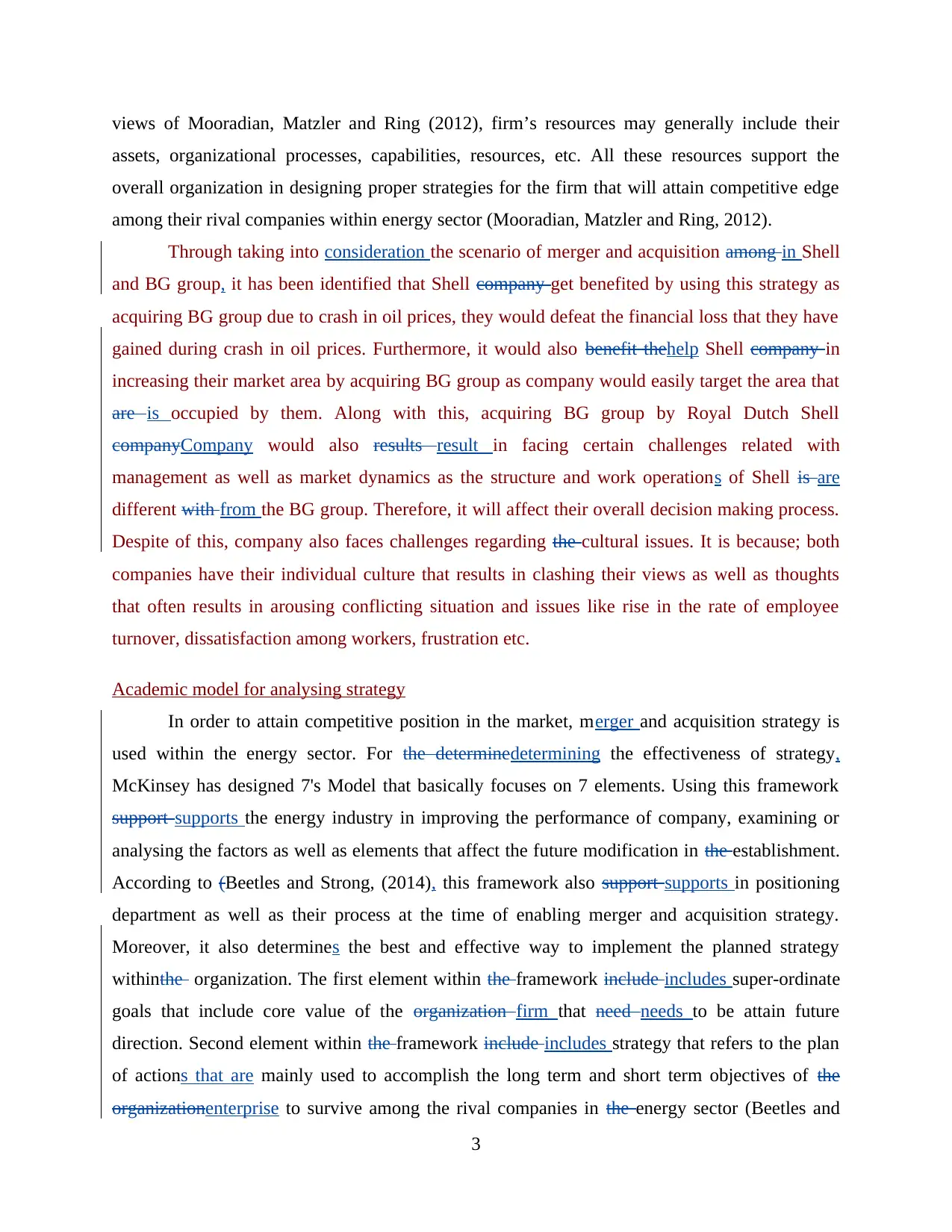
views of Mooradian, Matzler and Ring (2012), firm’s resources may generally include their
assets, organizational processes, capabilities, resources, etc. All these resources support the
overall organization in designing proper strategies for the firm that will attain competitive edge
among their rival companies within energy sector (Mooradian, Matzler and Ring, 2012).
Through taking into consideration the scenario of merger and acquisition among in Shell
and BG group, it has been identified that Shell company get benefited by using this strategy as
acquiring BG group due to crash in oil prices, they would defeat the financial loss that they have
gained during crash in oil prices. Furthermore, it would also benefit thehelp Shell company in
increasing their market area by acquiring BG group as company would easily target the area that
are is occupied by them. Along with this, acquiring BG group by Royal Dutch Shell
companyCompany would also results result in facing certain challenges related with
management as well as market dynamics as the structure and work operations of Shell is are
different with from the BG group. Therefore, it will affect their overall decision making process.
Despite of this, company also faces challenges regarding the cultural issues. It is because; both
companies have their individual culture that results in clashing their views as well as thoughts
that often results in arousing conflicting situation and issues like rise in the rate of employee
turnover, dissatisfaction among workers, frustration etc.
Academic model for analysing strategy
In order to attain competitive position in the market, merger and acquisition strategy is
used within the energy sector. For the determinedetermining the effectiveness of strategy,
McKinsey has designed 7's Model that basically focuses on 7 elements. Using this framework
support supports the energy industry in improving the performance of company, examining or
analysing the factors as well as elements that affect the future modification in the establishment.
According to (Beetles and Strong, (2014), this framework also support supports in positioning
department as well as their process at the time of enabling merger and acquisition strategy.
Moreover, it also determines the best and effective way to implement the planned strategy
withinthe organization. The first element within the framework include includes super-ordinate
goals that include core value of the organization firm that need needs to be attain future
direction. Second element within the framework include includes strategy that refers to the plan
of actions that are mainly used to accomplish the long term and short term objectives of the
organizationenterprise to survive among the rival companies in the energy sector (Beetles and
3
assets, organizational processes, capabilities, resources, etc. All these resources support the
overall organization in designing proper strategies for the firm that will attain competitive edge
among their rival companies within energy sector (Mooradian, Matzler and Ring, 2012).
Through taking into consideration the scenario of merger and acquisition among in Shell
and BG group, it has been identified that Shell company get benefited by using this strategy as
acquiring BG group due to crash in oil prices, they would defeat the financial loss that they have
gained during crash in oil prices. Furthermore, it would also benefit thehelp Shell company in
increasing their market area by acquiring BG group as company would easily target the area that
are is occupied by them. Along with this, acquiring BG group by Royal Dutch Shell
companyCompany would also results result in facing certain challenges related with
management as well as market dynamics as the structure and work operations of Shell is are
different with from the BG group. Therefore, it will affect their overall decision making process.
Despite of this, company also faces challenges regarding the cultural issues. It is because; both
companies have their individual culture that results in clashing their views as well as thoughts
that often results in arousing conflicting situation and issues like rise in the rate of employee
turnover, dissatisfaction among workers, frustration etc.
Academic model for analysing strategy
In order to attain competitive position in the market, merger and acquisition strategy is
used within the energy sector. For the determinedetermining the effectiveness of strategy,
McKinsey has designed 7's Model that basically focuses on 7 elements. Using this framework
support supports the energy industry in improving the performance of company, examining or
analysing the factors as well as elements that affect the future modification in the establishment.
According to (Beetles and Strong, (2014), this framework also support supports in positioning
department as well as their process at the time of enabling merger and acquisition strategy.
Moreover, it also determines the best and effective way to implement the planned strategy
withinthe organization. The first element within the framework include includes super-ordinate
goals that include core value of the organization firm that need needs to be attain future
direction. Second element within the framework include includes strategy that refers to the plan
of actions that are mainly used to accomplish the long term and short term objectives of the
organizationenterprise to survive among the rival companies in the energy sector (Beetles and
3
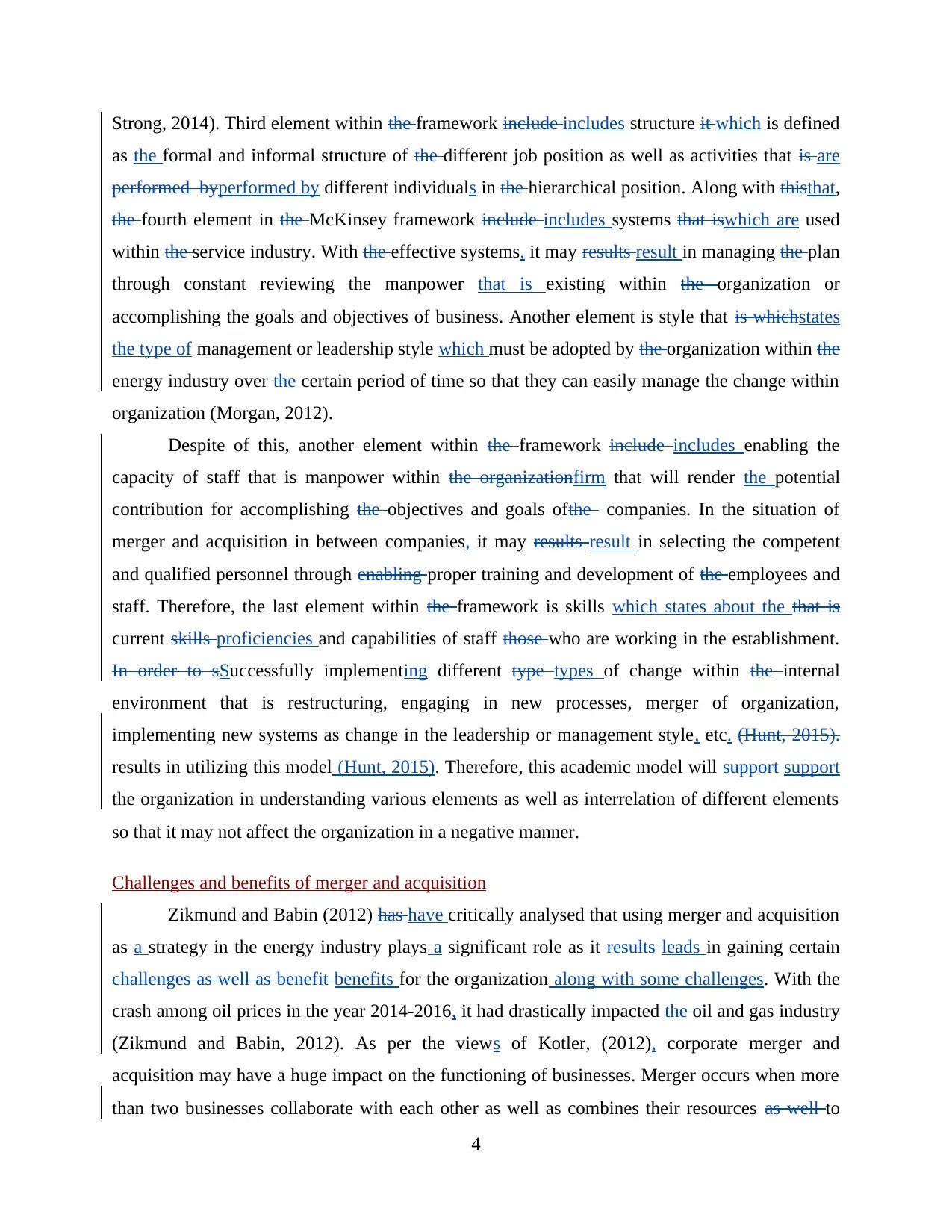
Strong, 2014). Third element within the framework include includes structure it which is defined
as the formal and informal structure of the different job position as well as activities that is are
performed byperformed by different individuals in the hierarchical position. Along with thisthat,
the fourth element in the McKinsey framework include includes systems that iswhich are used
within the service industry. With the effective systems, it may results result in managing the plan
through constant reviewing the manpower that is existing within the organization or
accomplishing the goals and objectives of business. Another element is style that is whichstates
the type of management or leadership style which must be adopted by the organization within the
energy industry over the certain period of time so that they can easily manage the change within
organization (Morgan, 2012).
Despite of this, another element within the framework include includes enabling the
capacity of staff that is manpower within the organizationfirm that will render the potential
contribution for accomplishing the objectives and goals ofthe companies. In the situation of
merger and acquisition in between companies, it may results result in selecting the competent
and qualified personnel through enabling proper training and development of the employees and
staff. Therefore, the last element within the framework is skills which states about the that is
current skills proficiencies and capabilities of staff those who are working in the establishment.
In order to sSuccessfully implementing different type types of change within the internal
environment that is restructuring, engaging in new processes, merger of organization,
implementing new systems as change in the leadership or management style, etc. (Hunt, 2015).
results in utilizing this model (Hunt, 2015). Therefore, this academic model will support support
the organization in understanding various elements as well as interrelation of different elements
so that it may not affect the organization in a negative manner.
Challenges and benefits of merger and acquisition
Zikmund and Babin (2012) has have critically analysed that using merger and acquisition
as a strategy in the energy industry plays a significant role as it results leads in gaining certain
challenges as well as benefit benefits for the organization along with some challenges. With the
crash among oil prices in the year 2014-2016, it had drastically impacted the oil and gas industry
(Zikmund and Babin, 2012). As per the views of Kotler, (2012), corporate merger and
acquisition may have a huge impact on the functioning of businesses. Merger occurs when more
than two businesses collaborate with each other as well as combines their resources as well to
4
as the formal and informal structure of the different job position as well as activities that is are
performed byperformed by different individuals in the hierarchical position. Along with thisthat,
the fourth element in the McKinsey framework include includes systems that iswhich are used
within the service industry. With the effective systems, it may results result in managing the plan
through constant reviewing the manpower that is existing within the organization or
accomplishing the goals and objectives of business. Another element is style that is whichstates
the type of management or leadership style which must be adopted by the organization within the
energy industry over the certain period of time so that they can easily manage the change within
organization (Morgan, 2012).
Despite of this, another element within the framework include includes enabling the
capacity of staff that is manpower within the organizationfirm that will render the potential
contribution for accomplishing the objectives and goals ofthe companies. In the situation of
merger and acquisition in between companies, it may results result in selecting the competent
and qualified personnel through enabling proper training and development of the employees and
staff. Therefore, the last element within the framework is skills which states about the that is
current skills proficiencies and capabilities of staff those who are working in the establishment.
In order to sSuccessfully implementing different type types of change within the internal
environment that is restructuring, engaging in new processes, merger of organization,
implementing new systems as change in the leadership or management style, etc. (Hunt, 2015).
results in utilizing this model (Hunt, 2015). Therefore, this academic model will support support
the organization in understanding various elements as well as interrelation of different elements
so that it may not affect the organization in a negative manner.
Challenges and benefits of merger and acquisition
Zikmund and Babin (2012) has have critically analysed that using merger and acquisition
as a strategy in the energy industry plays a significant role as it results leads in gaining certain
challenges as well as benefit benefits for the organization along with some challenges. With the
crash among oil prices in the year 2014-2016, it had drastically impacted the oil and gas industry
(Zikmund and Babin, 2012). As per the views of Kotler, (2012), corporate merger and
acquisition may have a huge impact on the functioning of businesses. Merger occurs when more
than two businesses collaborate with each other as well as combines their resources as well to
4
⊘ This is a preview!⊘
Do you want full access?
Subscribe today to unlock all pages.

Trusted by 1+ million students worldwide
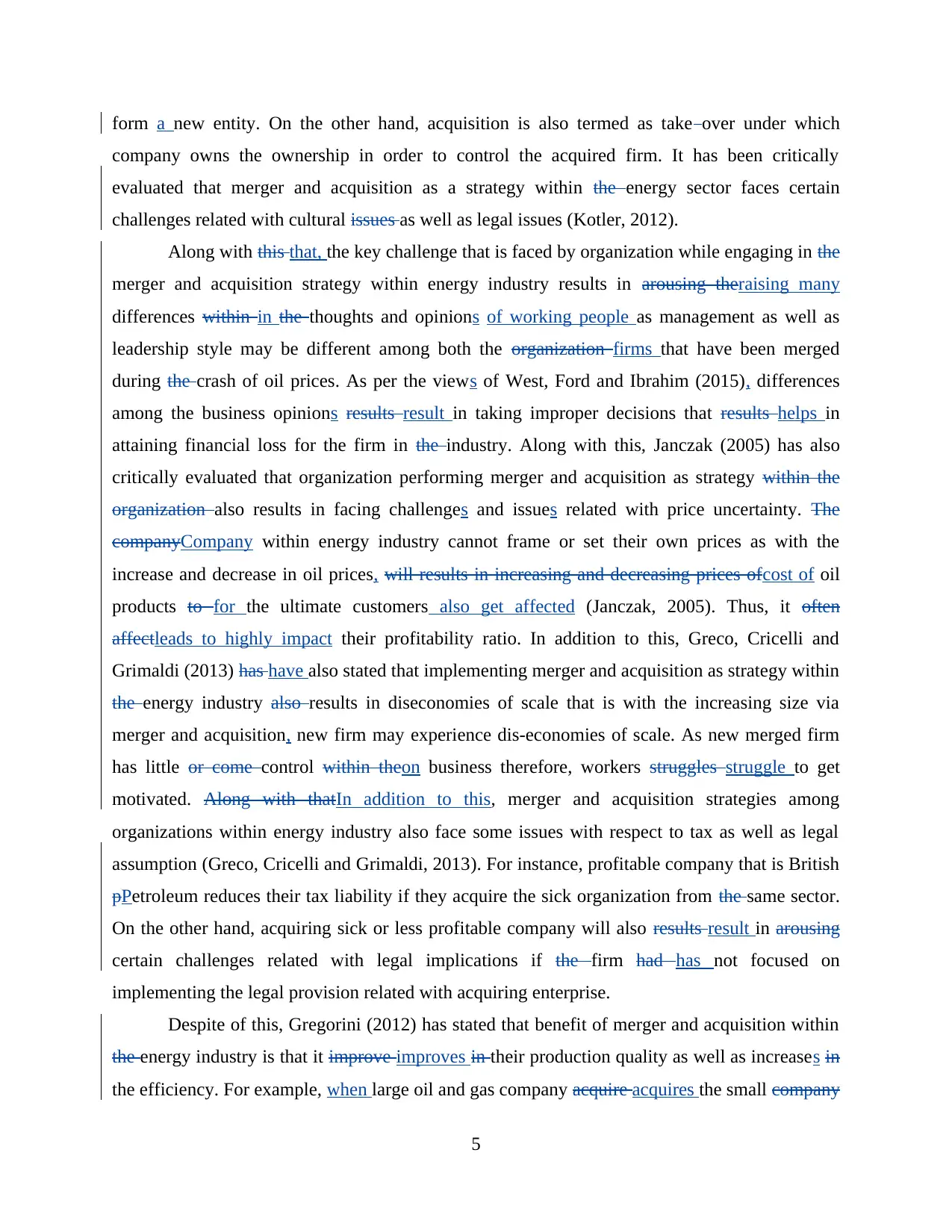
form a new entity. On the other hand, acquisition is also termed as take over under which
company owns the ownership in order to control the acquired firm. It has been critically
evaluated that merger and acquisition as a strategy within the energy sector faces certain
challenges related with cultural issues as well as legal issues (Kotler, 2012).
Along with this that, the key challenge that is faced by organization while engaging in the
merger and acquisition strategy within energy industry results in arousing theraising many
differences within in the thoughts and opinions of working people as management as well as
leadership style may be different among both the organization firms that have been merged
during the crash of oil prices. As per the views of West, Ford and Ibrahim (2015), differences
among the business opinions results result in taking improper decisions that results helps in
attaining financial loss for the firm in the industry. Along with this, Janczak (2005) has also
critically evaluated that organization performing merger and acquisition as strategy within the
organization also results in facing challenges and issues related with price uncertainty. The
companyCompany within energy industry cannot frame or set their own prices as with the
increase and decrease in oil prices, will results in increasing and decreasing prices ofcost of oil
products to for the ultimate customers also get affected (Janczak, 2005). Thus, it often
affectleads to highly impact their profitability ratio. In addition to this, Greco, Cricelli and
Grimaldi (2013) has have also stated that implementing merger and acquisition as strategy within
the energy industry also results in diseconomies of scale that is with the increasing size via
merger and acquisition, new firm may experience dis-economies of scale. As new merged firm
has little or come control within theon business therefore, workers struggles struggle to get
motivated. Along with thatIn addition to this, merger and acquisition strategies among
organizations within energy industry also face some issues with respect to tax as well as legal
assumption (Greco, Cricelli and Grimaldi, 2013). For instance, profitable company that is British
pPetroleum reduces their tax liability if they acquire the sick organization from the same sector.
On the other hand, acquiring sick or less profitable company will also results result in arousing
certain challenges related with legal implications if the firm had has not focused on
implementing the legal provision related with acquiring enterprise.
Despite of this, Gregorini (2012) has stated that benefit of merger and acquisition within
the energy industry is that it improve improves in their production quality as well as increases in
the efficiency. For example, when large oil and gas company acquire acquires the small company
5
company owns the ownership in order to control the acquired firm. It has been critically
evaluated that merger and acquisition as a strategy within the energy sector faces certain
challenges related with cultural issues as well as legal issues (Kotler, 2012).
Along with this that, the key challenge that is faced by organization while engaging in the
merger and acquisition strategy within energy industry results in arousing theraising many
differences within in the thoughts and opinions of working people as management as well as
leadership style may be different among both the organization firms that have been merged
during the crash of oil prices. As per the views of West, Ford and Ibrahim (2015), differences
among the business opinions results result in taking improper decisions that results helps in
attaining financial loss for the firm in the industry. Along with this, Janczak (2005) has also
critically evaluated that organization performing merger and acquisition as strategy within the
organization also results in facing challenges and issues related with price uncertainty. The
companyCompany within energy industry cannot frame or set their own prices as with the
increase and decrease in oil prices, will results in increasing and decreasing prices ofcost of oil
products to for the ultimate customers also get affected (Janczak, 2005). Thus, it often
affectleads to highly impact their profitability ratio. In addition to this, Greco, Cricelli and
Grimaldi (2013) has have also stated that implementing merger and acquisition as strategy within
the energy industry also results in diseconomies of scale that is with the increasing size via
merger and acquisition, new firm may experience dis-economies of scale. As new merged firm
has little or come control within theon business therefore, workers struggles struggle to get
motivated. Along with thatIn addition to this, merger and acquisition strategies among
organizations within energy industry also face some issues with respect to tax as well as legal
assumption (Greco, Cricelli and Grimaldi, 2013). For instance, profitable company that is British
pPetroleum reduces their tax liability if they acquire the sick organization from the same sector.
On the other hand, acquiring sick or less profitable company will also results result in arousing
certain challenges related with legal implications if the firm had has not focused on
implementing the legal provision related with acquiring enterprise.
Despite of this, Gregorini (2012) has stated that benefit of merger and acquisition within
the energy industry is that it improve improves in their production quality as well as increases in
the efficiency. For example, when large oil and gas company acquire acquires the small company
5
Paraphrase This Document
Need a fresh take? Get an instant paraphrase of this document with our AI Paraphraser
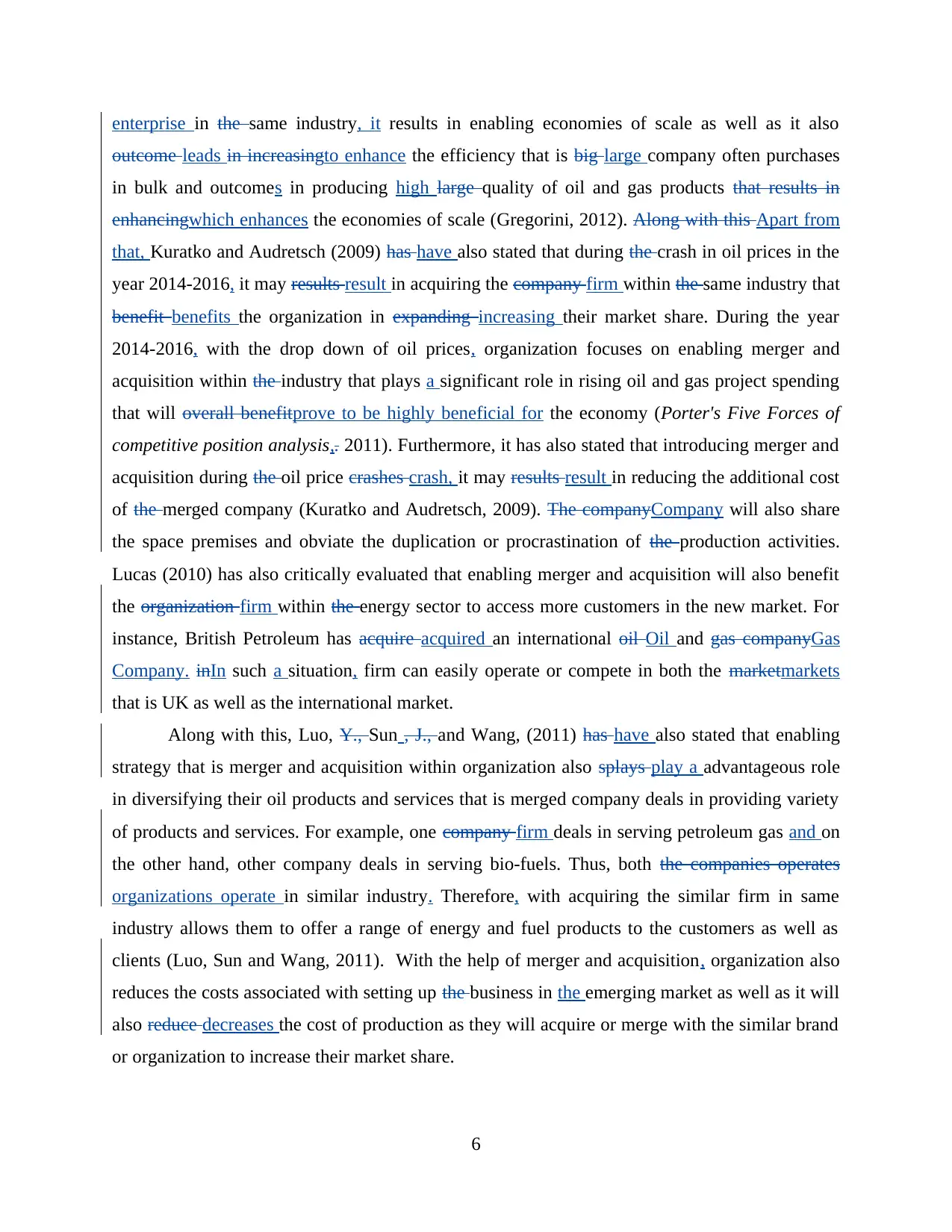
enterprise in the same industry, it results in enabling economies of scale as well as it also
outcome leads in increasingto enhance the efficiency that is big large company often purchases
in bulk and outcomes in producing high large quality of oil and gas products that results in
enhancingwhich enhances the economies of scale (Gregorini, 2012). Along with this Apart from
that, Kuratko and Audretsch (2009) has have also stated that during the crash in oil prices in the
year 2014-2016, it may results result in acquiring the company firm within the same industry that
benefit benefits the organization in expanding increasing their market share. During the year
2014-2016, with the drop down of oil prices, organization focuses on enabling merger and
acquisition within the industry that plays a significant role in rising oil and gas project spending
that will overall benefitprove to be highly beneficial for the economy (Porter's Five Forces of
competitive position analysis,. 2011). Furthermore, it has also stated that introducing merger and
acquisition during the oil price crashes crash, it may results result in reducing the additional cost
of the merged company (Kuratko and Audretsch, 2009). The companyCompany will also share
the space premises and obviate the duplication or procrastination of the production activities.
Lucas (2010) has also critically evaluated that enabling merger and acquisition will also benefit
the organization firm within the energy sector to access more customers in the new market. For
instance, British Petroleum has acquire acquired an international oil Oil and gas companyGas
Company. inIn such a situation, firm can easily operate or compete in both the marketmarkets
that is UK as well as the international market.
Along with this, Luo, Y., Sun , J., and Wang, (2011) has have also stated that enabling
strategy that is merger and acquisition within organization also splays play a advantageous role
in diversifying their oil products and services that is merged company deals in providing variety
of products and services. For example, one company firm deals in serving petroleum gas and on
the other hand, other company deals in serving bio-fuels. Thus, both the companies operates
organizations operate in similar industry. Therefore, with acquiring the similar firm in same
industry allows them to offer a range of energy and fuel products to the customers as well as
clients (Luo, Sun and Wang, 2011). With the help of merger and acquisition, organization also
reduces the costs associated with setting up the business in the emerging market as well as it will
also reduce decreases the cost of production as they will acquire or merge with the similar brand
or organization to increase their market share.
6
outcome leads in increasingto enhance the efficiency that is big large company often purchases
in bulk and outcomes in producing high large quality of oil and gas products that results in
enhancingwhich enhances the economies of scale (Gregorini, 2012). Along with this Apart from
that, Kuratko and Audretsch (2009) has have also stated that during the crash in oil prices in the
year 2014-2016, it may results result in acquiring the company firm within the same industry that
benefit benefits the organization in expanding increasing their market share. During the year
2014-2016, with the drop down of oil prices, organization focuses on enabling merger and
acquisition within the industry that plays a significant role in rising oil and gas project spending
that will overall benefitprove to be highly beneficial for the economy (Porter's Five Forces of
competitive position analysis,. 2011). Furthermore, it has also stated that introducing merger and
acquisition during the oil price crashes crash, it may results result in reducing the additional cost
of the merged company (Kuratko and Audretsch, 2009). The companyCompany will also share
the space premises and obviate the duplication or procrastination of the production activities.
Lucas (2010) has also critically evaluated that enabling merger and acquisition will also benefit
the organization firm within the energy sector to access more customers in the new market. For
instance, British Petroleum has acquire acquired an international oil Oil and gas companyGas
Company. inIn such a situation, firm can easily operate or compete in both the marketmarkets
that is UK as well as the international market.
Along with this, Luo, Y., Sun , J., and Wang, (2011) has have also stated that enabling
strategy that is merger and acquisition within organization also splays play a advantageous role
in diversifying their oil products and services that is merged company deals in providing variety
of products and services. For example, one company firm deals in serving petroleum gas and on
the other hand, other company deals in serving bio-fuels. Thus, both the companies operates
organizations operate in similar industry. Therefore, with acquiring the similar firm in same
industry allows them to offer a range of energy and fuel products to the customers as well as
clients (Luo, Sun and Wang, 2011). With the help of merger and acquisition, organization also
reduces the costs associated with setting up the business in the emerging market as well as it will
also reduce decreases the cost of production as they will acquire or merge with the similar brand
or organization to increase their market share.
6
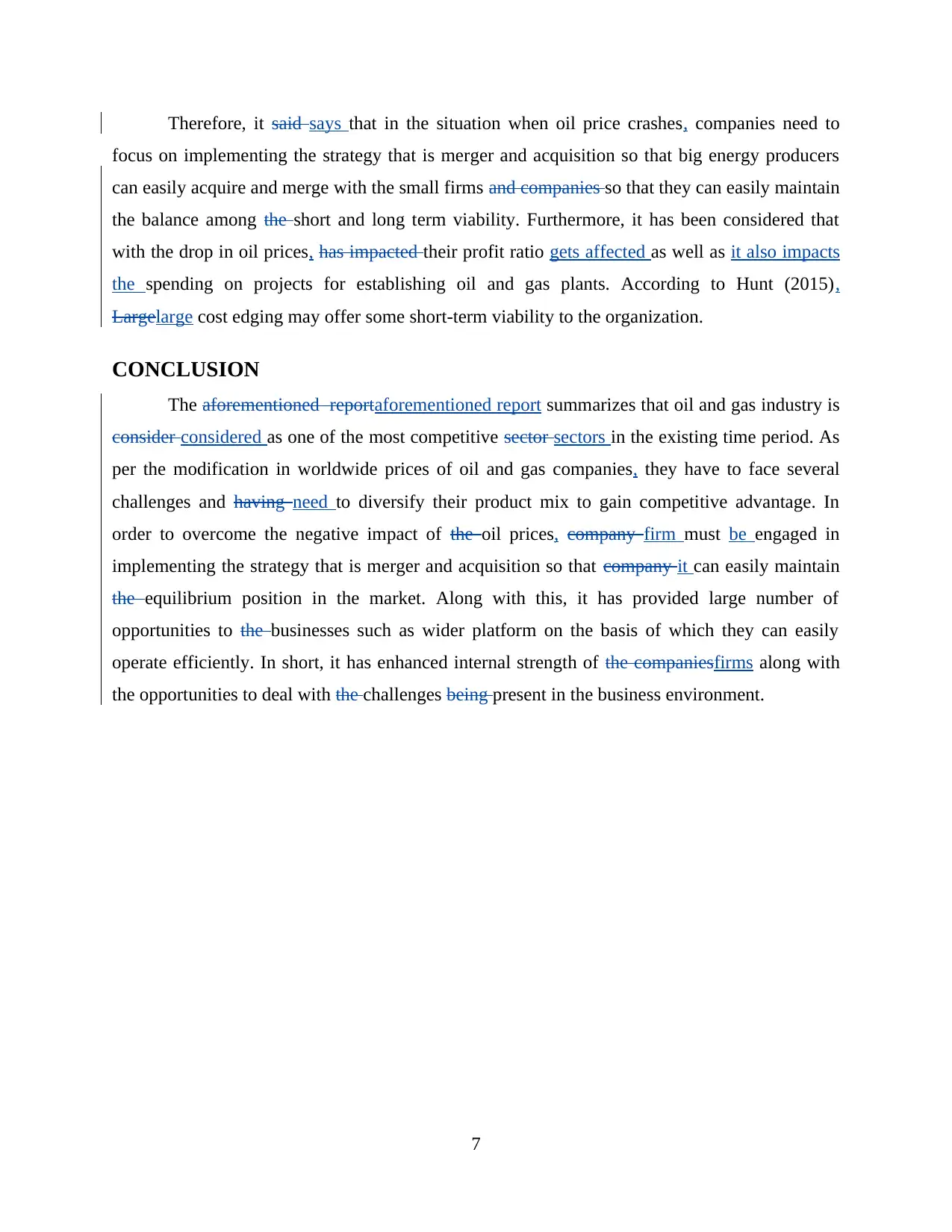
Therefore, it said says that in the situation when oil price crashes, companies need to
focus on implementing the strategy that is merger and acquisition so that big energy producers
can easily acquire and merge with the small firms and companies so that they can easily maintain
the balance among the short and long term viability. Furthermore, it has been considered that
with the drop in oil prices, has impacted their profit ratio gets affected as well as it also impacts
the spending on projects for establishing oil and gas plants. According to Hunt (2015),
Largelarge cost edging may offer some short-term viability to the organization.
CONCLUSION
The aforementioned reportaforementioned report summarizes that oil and gas industry is
consider considered as one of the most competitive sector sectors in the existing time period. As
per the modification in worldwide prices of oil and gas companies, they have to face several
challenges and having need to diversify their product mix to gain competitive advantage. In
order to overcome the negative impact of the oil prices, company firm must be engaged in
implementing the strategy that is merger and acquisition so that company it can easily maintain
the equilibrium position in the market. Along with this, it has provided large number of
opportunities to the businesses such as wider platform on the basis of which they can easily
operate efficiently. In short, it has enhanced internal strength of the companiesfirms along with
the opportunities to deal with the challenges being present in the business environment.
7
focus on implementing the strategy that is merger and acquisition so that big energy producers
can easily acquire and merge with the small firms and companies so that they can easily maintain
the balance among the short and long term viability. Furthermore, it has been considered that
with the drop in oil prices, has impacted their profit ratio gets affected as well as it also impacts
the spending on projects for establishing oil and gas plants. According to Hunt (2015),
Largelarge cost edging may offer some short-term viability to the organization.
CONCLUSION
The aforementioned reportaforementioned report summarizes that oil and gas industry is
consider considered as one of the most competitive sector sectors in the existing time period. As
per the modification in worldwide prices of oil and gas companies, they have to face several
challenges and having need to diversify their product mix to gain competitive advantage. In
order to overcome the negative impact of the oil prices, company firm must be engaged in
implementing the strategy that is merger and acquisition so that company it can easily maintain
the equilibrium position in the market. Along with this, it has provided large number of
opportunities to the businesses such as wider platform on the basis of which they can easily
operate efficiently. In short, it has enhanced internal strength of the companiesfirms along with
the opportunities to deal with the challenges being present in the business environment.
7
⊘ This is a preview!⊘
Do you want full access?
Subscribe today to unlock all pages.

Trusted by 1+ million students worldwide
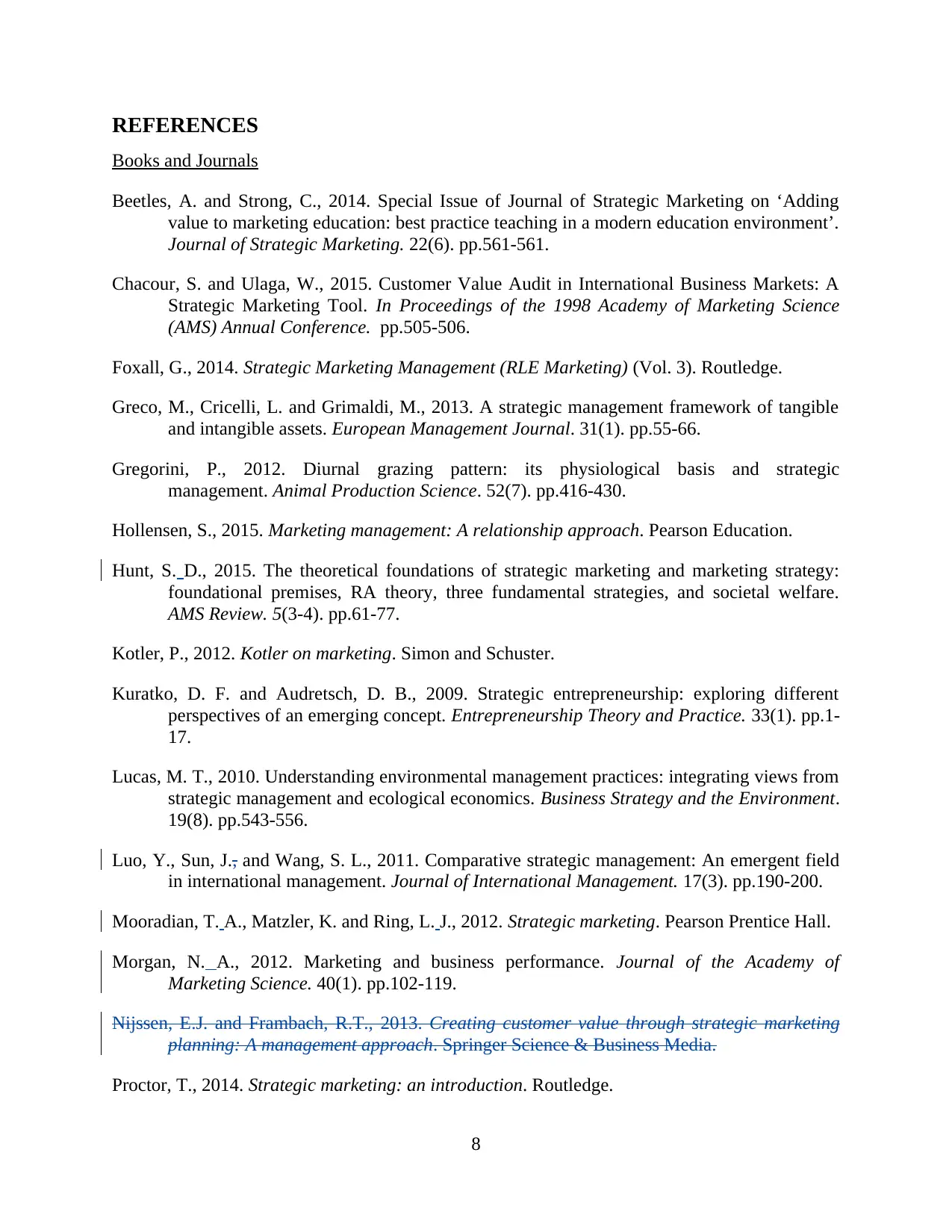
REFERENCES
Books and Journals
Beetles, A. and Strong, C., 2014. Special Issue of Journal of Strategic Marketing on ‘Adding
value to marketing education: best practice teaching in a modern education environment’.
Journal of Strategic Marketing. 22(6). pp.561-561.
Chacour, S. and Ulaga, W., 2015. Customer Value Audit in International Business Markets: A
Strategic Marketing Tool. In Proceedings of the 1998 Academy of Marketing Science
(AMS) Annual Conference. pp.505-506.
Foxall, G., 2014. Strategic Marketing Management (RLE Marketing) (Vol. 3). Routledge.
Greco, M., Cricelli, L. and Grimaldi, M., 2013. A strategic management framework of tangible
and intangible assets. European Management Journal. 31(1). pp.55-66.
Gregorini, P., 2012. Diurnal grazing pattern: its physiological basis and strategic
management. Animal Production Science. 52(7). pp.416-430.
Hollensen, S., 2015. Marketing management: A relationship approach. Pearson Education.
Hunt, S. D., 2015. The theoretical foundations of strategic marketing and marketing strategy:
foundational premises, RA theory, three fundamental strategies, and societal welfare.
AMS Review. 5(3-4). pp.61-77.
Kotler, P., 2012. Kotler on marketing. Simon and Schuster.
Kuratko, D. F. and Audretsch, D. B., 2009. Strategic entrepreneurship: exploring different
perspectives of an emerging concept. Entrepreneurship Theory and Practice. 33(1). pp.1-
17.
Lucas, M. T., 2010. Understanding environmental management practices: integrating views from
strategic management and ecological economics. Business Strategy and the Environment.
19(8). pp.543-556.
Luo, Y., Sun, J., and Wang, S. L., 2011. Comparative strategic management: An emergent field
in international management. Journal of International Management. 17(3). pp.190-200.
Mooradian, T. A., Matzler, K. and Ring, L. J., 2012. Strategic marketing. Pearson Prentice Hall.
Morgan, N. A., 2012. Marketing and business performance. Journal of the Academy of
Marketing Science. 40(1). pp.102-119.
Nijssen, E.J. and Frambach, R.T., 2013. Creating customer value through strategic marketing
planning: A management approach. Springer Science & Business Media.
Proctor, T., 2014. Strategic marketing: an introduction. Routledge.
8
Books and Journals
Beetles, A. and Strong, C., 2014. Special Issue of Journal of Strategic Marketing on ‘Adding
value to marketing education: best practice teaching in a modern education environment’.
Journal of Strategic Marketing. 22(6). pp.561-561.
Chacour, S. and Ulaga, W., 2015. Customer Value Audit in International Business Markets: A
Strategic Marketing Tool. In Proceedings of the 1998 Academy of Marketing Science
(AMS) Annual Conference. pp.505-506.
Foxall, G., 2014. Strategic Marketing Management (RLE Marketing) (Vol. 3). Routledge.
Greco, M., Cricelli, L. and Grimaldi, M., 2013. A strategic management framework of tangible
and intangible assets. European Management Journal. 31(1). pp.55-66.
Gregorini, P., 2012. Diurnal grazing pattern: its physiological basis and strategic
management. Animal Production Science. 52(7). pp.416-430.
Hollensen, S., 2015. Marketing management: A relationship approach. Pearson Education.
Hunt, S. D., 2015. The theoretical foundations of strategic marketing and marketing strategy:
foundational premises, RA theory, three fundamental strategies, and societal welfare.
AMS Review. 5(3-4). pp.61-77.
Kotler, P., 2012. Kotler on marketing. Simon and Schuster.
Kuratko, D. F. and Audretsch, D. B., 2009. Strategic entrepreneurship: exploring different
perspectives of an emerging concept. Entrepreneurship Theory and Practice. 33(1). pp.1-
17.
Lucas, M. T., 2010. Understanding environmental management practices: integrating views from
strategic management and ecological economics. Business Strategy and the Environment.
19(8). pp.543-556.
Luo, Y., Sun, J., and Wang, S. L., 2011. Comparative strategic management: An emergent field
in international management. Journal of International Management. 17(3). pp.190-200.
Mooradian, T. A., Matzler, K. and Ring, L. J., 2012. Strategic marketing. Pearson Prentice Hall.
Morgan, N. A., 2012. Marketing and business performance. Journal of the Academy of
Marketing Science. 40(1). pp.102-119.
Nijssen, E.J. and Frambach, R.T., 2013. Creating customer value through strategic marketing
planning: A management approach. Springer Science & Business Media.
Proctor, T., 2014. Strategic marketing: an introduction. Routledge.
8
Paraphrase This Document
Need a fresh take? Get an instant paraphrase of this document with our AI Paraphraser
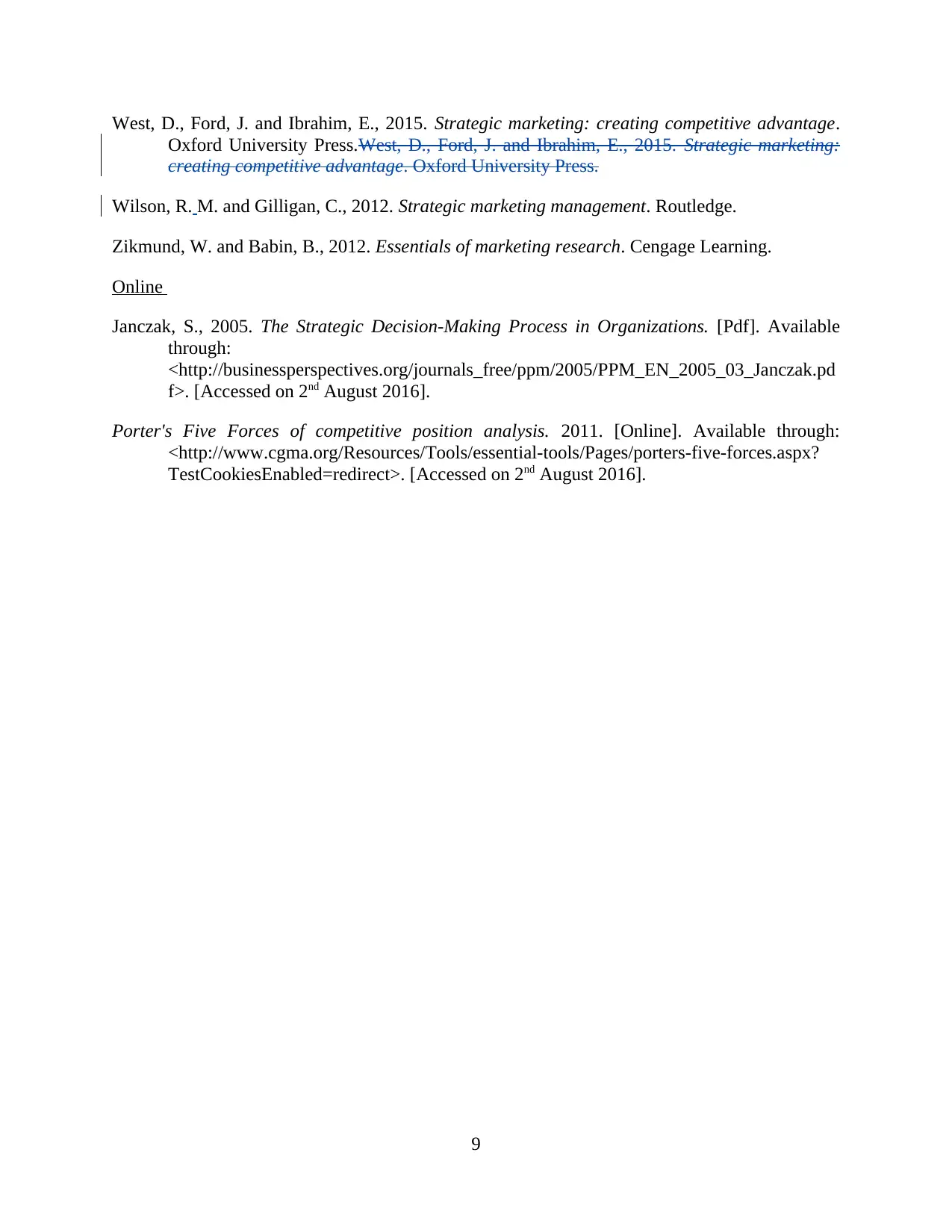
West, D., Ford, J. and Ibrahim, E., 2015. Strategic marketing: creating competitive advantage.
Oxford University Press.West, D., Ford, J. and Ibrahim, E., 2015. Strategic marketing:
creating competitive advantage. Oxford University Press.
Wilson, R. M. and Gilligan, C., 2012. Strategic marketing management. Routledge.
Zikmund, W. and Babin, B., 2012. Essentials of marketing research. Cengage Learning.
Online
Janczak, S., 2005. The Strategic Decision-Making Process in Organizations. [Pdf]. Available
through:
<http://businessperspectives.org/journals_free/ppm/2005/PPM_EN_2005_03_Janczak.pd
f>. [Accessed on 2nd August 2016].
Porter's Five Forces of competitive position analysis. 2011. [Online]. Available through:
<http://www.cgma.org/Resources/Tools/essential-tools/Pages/porters-five-forces.aspx?
TestCookiesEnabled=redirect>. [Accessed on 2nd August 2016].
9
Oxford University Press.West, D., Ford, J. and Ibrahim, E., 2015. Strategic marketing:
creating competitive advantage. Oxford University Press.
Wilson, R. M. and Gilligan, C., 2012. Strategic marketing management. Routledge.
Zikmund, W. and Babin, B., 2012. Essentials of marketing research. Cengage Learning.
Online
Janczak, S., 2005. The Strategic Decision-Making Process in Organizations. [Pdf]. Available
through:
<http://businessperspectives.org/journals_free/ppm/2005/PPM_EN_2005_03_Janczak.pd
f>. [Accessed on 2nd August 2016].
Porter's Five Forces of competitive position analysis. 2011. [Online]. Available through:
<http://www.cgma.org/Resources/Tools/essential-tools/Pages/porters-five-forces.aspx?
TestCookiesEnabled=redirect>. [Accessed on 2nd August 2016].
9
1 out of 11
Related Documents
Your All-in-One AI-Powered Toolkit for Academic Success.
+13062052269
info@desklib.com
Available 24*7 on WhatsApp / Email
![[object Object]](/_next/static/media/star-bottom.7253800d.svg)
Unlock your academic potential
Copyright © 2020–2025 A2Z Services. All Rights Reserved. Developed and managed by ZUCOL.





